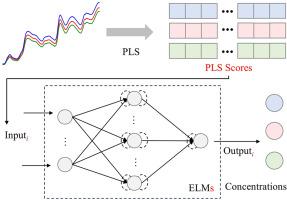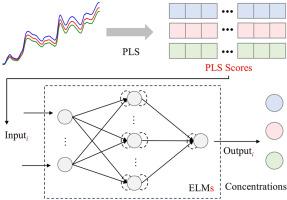PLSELM:一种用于近红外光谱低数据校准的轻量级建模方法
IF 6
2区 化学
Q1 CHEMISTRY, ANALYTICAL
引用次数: 0
摘要
近红外光谱作为一种快速分析技术,以其在线监测和无损检测的优点被广泛应用于各个领域。它可以提供丰富的化学信息,对研究物质的结构、组成和变化具有重要意义。可靠的校准仍然是近红外(NIR)光谱学的主要挑战,特别是在低数据条件下或不同配置的仪器之间。为了解决这个问题,我们提出了PLSELM,一种轻量级的建模校准方法,它结合了偏最小二乘(PLS)分数矩阵和集成极限学习机(ELM)。为了解决这个问题,我们提出了一种轻量级建模校准方法PLSELM,该方法结合了偏最小二乘(PLS)分数矩阵和集成极限学习机(ELM)。通过建模潜在PLS特征和浓化值之间的关系,PLSELM提供了一个快速,稳健和可转移的校准框架。为了评估其性能,使用了5种不同的近红外光谱数据,包括来自10种不同光谱仪的21组浓度指标,进行基准比较。这些近红外光谱具有不同的波长范围、分辨率、长度和广泛的浓度范围。结果表明,PLSELM具有出色的校准性能,优于传统的PLS、支持向量回归和基于深度学习的模型。PLSELM在低数据学习和校准传递分析中也有很好的适用性。此外,PLSELM模型具有良好的鲁棒性,表现为对样本划分的随机性和隐层节点的随机性不敏感。PLSELM在玉米数据上完成PLSELM和PLS模型只用了0.5秒。综合比较结果表明,PLSELM方法是一种鲁棒的近红外校准方法,在不同的光谱波长范围、分辨率、长度和浓度范围内都有良好的性能。总之,PLSELM为近红外校准提供了实用且可扩展的解决方案,在涉及有限数据或异构仪器的实际分析应用中具有极好的潜力。本文章由计算机程序翻译,如有差异,请以英文原文为准。


PLSELM: A lightweight modeling approach for low-data calibration in near-infrared spectroscopy
Background
Near infrared (NIR) spectroscopy is widely used as a rapid analytical technique in various fields for its advantages of on-line monitoring and non-destructive testing. It can provide rich chemical information and is of great significance for studying the structure, composition and changes of substances. Reliable calibration remains a major challenge in near-infrared (NIR) spectroscopy, especially under low-data conditions or across instruments with varying configurations. To address this, we propose PLSELM, a lightweight modeling calibration method, which combines Partial Least Squares (PLS) score matrices and Ensemble Extreme Learning Machine (ELM).
Results
To address this, we propose PLSELM, a lightweight modeling calibration method, which combines Partial Least Squares (PLS) score matrices and Ensemble Extreme Learning Machine (ELM). By modeling the relationship between latent PLS features and concentration values, PLSELM provides a fast, robust, and transferable calibration framework. To evaluating the performance, five diverse NIR spectral data, including 21 sets of concentration indicators from 10 different spectrometers, were used for benchmarking comparison. These NIR spectra have different wavelength ranges, resolutions, lengths, and a wide range of concentrations. Results demonstrate that PLSELM has excellent calibration performance, outperforming conventional PLS, Support Vector Regression, and deep learning-based models. PLSELM also has great suitability in low-data learning and calibration transfer analysis. In addition, PLSELM model has good robustness, which is manifested in that it is not sensitive to the randomness of sample division and the randomness of hidden layer nodes. PLSELM only took 0.5 s to finished the PLSELM and PLS models on corn data.
Significance
The comprehensive comparison results indicate that the PLSELM method is a robust NIR calibration method, which performs well in various spectral wavelength ranges, resolutions, lengths, and a wide range of concentrations. In summary, PLSELM offers a practical and scalable solution for NIR calibration, with excellent potential for use in real-world analytical applications involving limited data or heterogeneous instruments.
求助全文
通过发布文献求助,成功后即可免费获取论文全文。
去求助
来源期刊

Analytica Chimica Acta
化学-分析化学
CiteScore
10.40
自引率
6.50%
发文量
1081
审稿时长
38 days
期刊介绍:
Analytica Chimica Acta has an open access mirror journal Analytica Chimica Acta: X, sharing the same aims and scope, editorial team, submission system and rigorous peer review.
Analytica Chimica Acta provides a forum for the rapid publication of original research, and critical, comprehensive reviews dealing with all aspects of fundamental and applied modern analytical chemistry. The journal welcomes the submission of research papers which report studies concerning the development of new and significant analytical methodologies. In determining the suitability of submitted articles for publication, particular scrutiny will be placed on the degree of novelty and impact of the research and the extent to which it adds to the existing body of knowledge in analytical chemistry.
 求助内容:
求助内容: 应助结果提醒方式:
应助结果提醒方式:


